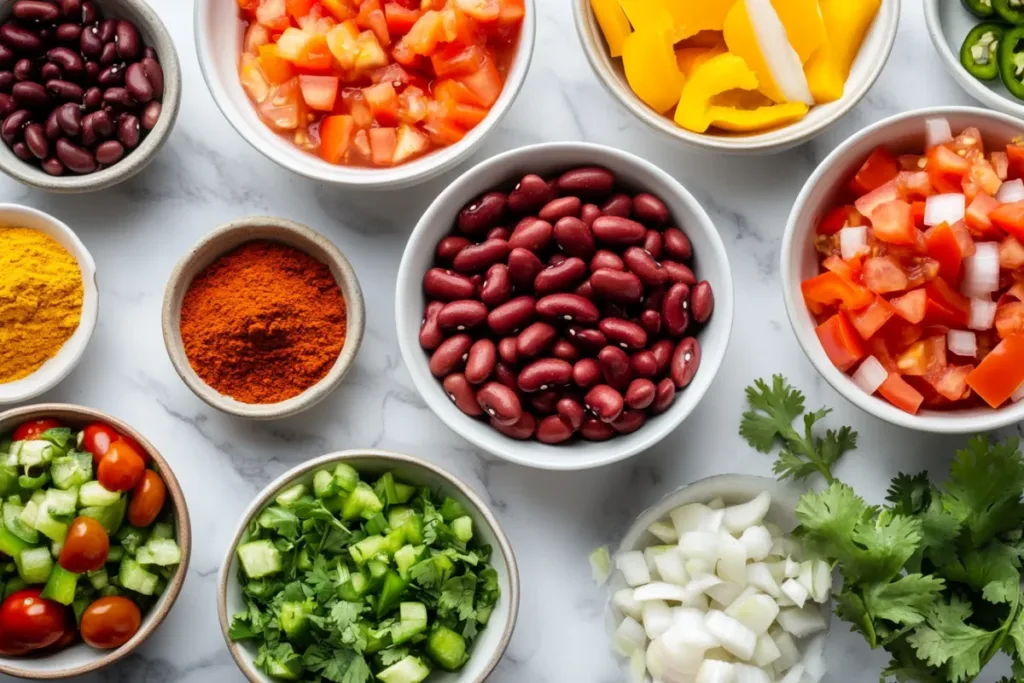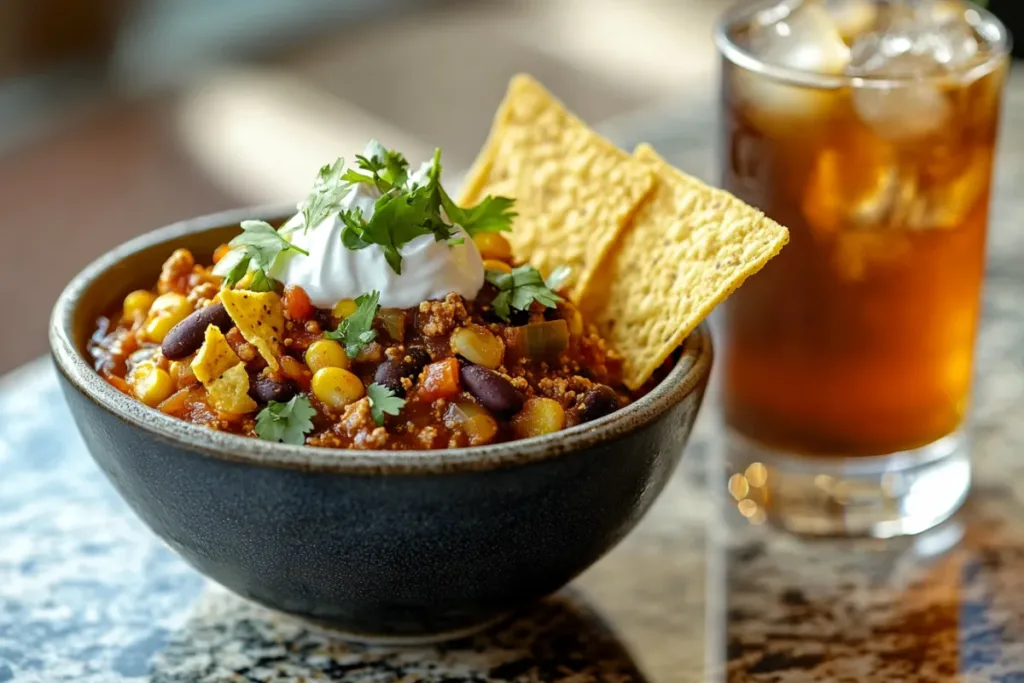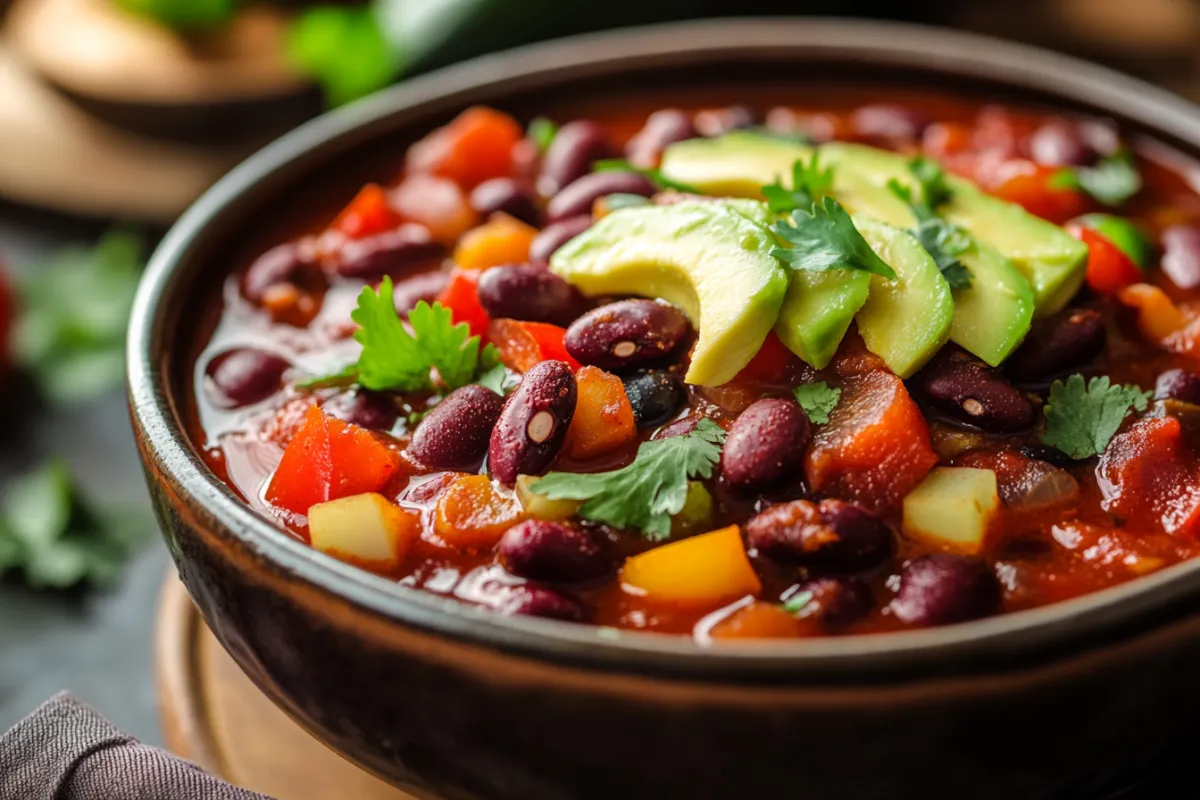Vegetarian chili is a versatile, flavorful dish that appeals to everyone, from devout meat-eaters to strict vegetarians. This delightful meal is packed with hearty beans, fresh vegetables, and a unique blend of spices, making it the perfect comfort food for any occasion.
Introduction to Vegetarian Chili
There’s something special about a bowl of vegetarian chili—it’s warm, comforting, and packed with flavors that remind us of traditional chili recipes, but without the meat. This dish has evolved over the years to embrace ingredients that provide both texture and taste, making it a favorite for vegetarians and vegans alike.
The Origins and History of Chili
Chili, also known as chili con carne, originated in the southwestern United States and Mexico. Traditionally, chili was a meat-heavy dish prepared with chili peppers, meat, and often tomatoes. However, over time, vegetarian versions of this iconic dish have become popular as well. Today’s vegetarian chili still maintains the heartiness of the original while offering a plant-based twist.
Why Vegetarian Chili?
Vegetarian chili isn’t just for vegetarians—it’s a healthy, hearty option that appeals to anyone looking for a delicious, nutrient-dense meal. The combination of beans, vegetables, and spices makes it rich in protein, fiber, vitamins, and minerals. Plus, it’s easy to customize with different ingredients and seasonings, making it a great choice for those with specific dietary preferences or restrictions.
Key Ingredients for Vegetarian Chili
Vegetarian chili relies on a mix of flavorful ingredients that work together to create a deliciously satisfying dish. Here’s a breakdown of the essential components:

Beans: The Heart of the Chili
Beans are a staple in vegetarian chili, providing protein, fiber, and a satisfying texture. Popular options include:
- Kidney Beans: Known for their firm texture and ability to absorb flavors, kidney beans are a chili classic.
- Black Beans: These beans are slightly sweet, providing a contrast to the spices in the chili.
- Pinto Beans: Creamy and soft, pinto beans add a velvety texture.
For extra variety, try mixing different types of beans or adding chickpeas for a unique twist.
Vegetables: Adding Flavor and Nutrients
Vegetables play a vital role in vegetarian chili, adding bulk, flavor, and nutrients. Consider including:
- Onions and Garlic: Essential aromatics that form the base of most chili recipes.
- Bell Peppers: Available in various colors, bell peppers add sweetness and a pop of color.
- Carrots, Zucchini, and Celery: These vegetables enhance the texture and provide additional nutrients.
- Corn: Adds a subtle sweetness and color contrast.
Using seasonal vegetables is another way to customize your chili and take advantage of fresh produce throughout the year.
Spices and Seasonings: Creating Depth of Flavor
The spices are what set chili apart from other stews. Each spice contributes a unique flavor, and together, they create a complex and satisfying taste:
- Chili Powder: A blend that typically includes cayenne, cumin, and paprika.
- Cumin: Provides a warm, earthy undertone that complements the chili powder.
- Paprika (Sweet or Smoked): Adds color and depth. Smoked paprika lends a smoky flavor.
- Cayenne or Chipotle Powder: For those who like a kick, these spices add heat and smokiness.
- Oregano and Bay Leaves: Herbs that add an extra layer of complexity to the flavor profile.
Feel free to experiment with different spice blends, adjusting the heat and smokiness to suit your preferences.
Alternative Proteins and Texture Enhancers
If you’d like to boost the protein content of your chili or add variety, consider these ingredients:
- Tofu: Crumble or cube and cook separately before adding to the chili for a hearty texture.
- Tempeh: Fermented soybeans with a nutty flavor that can be crumbled into the chili.
- Plant-Based Meat Crumbles: These can mimic the texture of traditional chili, making it even heartier.
You can also try adding grains like quinoa or bulgur for a protein and texture boost.
Liquid Ingredients: Building the Broth
The liquid in chili serves as the medium that brings all the flavors together. Common options include:
- Vegetable Broth: Provides depth and a savory base for the chili.
- Tomato Sauce, Crushed Tomatoes, or Diced Tomatoes: These add acidity, sweetness, and thickness to the chili. Fire-roasted tomatoes can add a smoky flavor.
- Beer or Coffee: Adding a small amount of beer or coffee can enhance the flavor profile, adding bitterness or richness. Use sparingly and taste as you go.
For a creamier texture, consider adding a splash of coconut milk or a dollop of Greek yogurt when serving.
Cooking Methods for Vegetarian Chili
Vegetarian chili can be made using a variety of cooking methods, each offering unique benefits. Here are four popular methods:
Stovetop
The stovetop is a classic method for making chili. It allows for maximum control over the cooking process:
- Sauté the Vegetables: Start by heating oil in a large pot and adding onions, garlic, and bell peppers. Sauté until soft and fragrant.
- Add Spices: Toast the spices briefly to bring out their flavors before adding the beans and liquids.
- Simmer: Let the chili cook on low heat for 45 minutes to an hour, stirring occasionally to prevent sticking.
Slow Cooker
The slow cooker is perfect for a hands-off cooking experience, allowing you to set it and forget it:
- Pre-Cook Vegetables (Optional): Sautéing the vegetables first enhances their flavor but isn’t necessary.
- Combine Ingredients: Add everything to the slow cooker, including the spices, beans, and liquids.
- Cook on Low: Set to low and cook for 6-8 hours, or on high for 3-4 hours.
Slow-cooked chili has a deep, well-rounded flavor as the ingredients have plenty of time to meld.
Instant Pot
The Instant Pot is ideal for quick cooking without compromising flavor:
- Sauté Vegetables: Use the sauté function to cook the onions, garlic, and peppers with spices.
- Add Remaining Ingredients: Pour in the beans, broth, tomatoes, and any additional vegetables.
- Pressure Cook: Seal the lid and cook on high pressure for 15-20 minutes.
Baking with Tofu
For a unique twist, try baking the tofu separately:
- Crumble or Cube Tofu: Season and bake at 400°F (200°C) for 20-30 minutes until crispy.
- Add to Chili: Stir the baked tofu into the chili during the last 10 minutes of cooking.
Recipe Variations and Customizations
One of the best aspects of vegetarian chili is how adaptable it is. Here are some popular variations to consider:
Classic Vegetarian Chili
The classic version emphasizes beans, tomatoes, and a blend of spices. It’s simple yet packed with flavor, perfect for beginners.
Spicy Chili
For those who enjoy heat, add jalapeños, chipotle peppers, or extra cayenne. You can also include hot sauce for an additional kick.
Smoky Chili
Add smoked paprika or fire-roasted tomatoes for a smoky flavor. You can also include chipotle peppers in adobo sauce for extra smokiness and heat.
High-Protein Chili
Boost the protein content with grains like quinoa or lentils, or use chickpeas in addition to beans.
Sweet Potato Chili
Sweet potatoes add a sweet contrast to the savory spices, creating a perfect balance. Diced sweet potatoes can be added at the beginning of cooking.
White Bean and Kale Chili
For a lighter, greener version, use white beans and add kale or spinach towards the end of cooking.
Serving Suggestions
Vegetarian chili can be served with a variety of toppings and sides to make it even more satisfying:
Toppings
Toppings can add color, texture, and flavor to the chili:
- Sliced Avocado: Creamy avocado adds a rich contrast to the chili.
- Tortilla Chips or Corn Chips: For a crunchy texture, serve with tortilla chips on the side.
- Cilantro and Lime Wedges: Fresh cilantro and a squeeze of lime juice brighten the flavors.
Side Dishes
Pair your chili with classic sides for a more substantial meal:
- Cornbread: A slightly sweet cornbread pairs perfectly with spicy chili.
- Baked Potatoes: Pour chili over a baked potato for a hearty meal.
- Rice or Quinoa: These grains can be served on the side or mixed directly into the chili.
Beverage Pairings
Choose drinks that complement the chili’s flavors:

- Iced Tea: Refreshing and balances the heat from the chili.
- Lemonade or Limeade: The citrus notes complement the spices and cleanse the palate.
How to Store and Reheat Vegetarian Chili
Chili is a great dish for meal prep, as it stores well and often tastes even better the next day:
Refrigeration
Allow chili to cool before transferring it to an airtight container. It will last in the fridge for up to five days.
Freezing Tips
Chili freezes well, making it ideal for batch cooking. Freeze in individual portions for easy reheating. It can last in the freezer for up to three months.
Reheating
When ready to eat, reheat in a pot on the stovetop or in the microwave. For a fresher taste, add a dash of fresh lime juice or a sprinkle of fresh herbs after reheating.
FAQs
What are the best beans for vegetarian chili?
Kidney and black beans are popular due to their texture and flavor. Pinto beans are also a great choice for a creamier chili.
Can vegetarian chili be made in advance?
Yes, it’s an excellent make-ahead meal. In fact, chili often tastes better the next day.
Is vegetarian chili gluten-free?
Typically, yes, as long as all ingredients are gluten-free. Double-check spices and any pre-packaged ingredients.
How do I thicken vegetarian chili?
To thicken chili, you can simmer it uncovered to reduce the liquid, or mash a portion of the beans to release their starch.
Can I make vegetarian chili without beans?
Yes, you can substitute beans with lentils, quinoa, or diced sweet potatoes for texture.
For more delightful recipes, visit our homepage.
Print
Vegetarian Chili: A Hearty Meat-Free Delight
- Total Time: 40 minutes
Description
A comforting and flavorful meat-free dish, vegetarian chili is packed with hearty beans, colorful vegetables, and a rich blend of spices, perfect for warming up on a chilly day.
Ingredients
For the Chili:
- 1 tablespoon olive oil
- 1 large onion, chopped
- 1 bell pepper, chopped
- 3 cloves garlic, minced
- 1 can (15 oz) black beans, drained and rinsed
- 1 can (15 oz) kidney beans, drained and rinsed
- 1 can (15 oz) diced tomatoes
- 1 can (15 oz) tomato sauce
- 1 cup vegetable broth
- 2 tablespoons chili powder
- 1 teaspoon cumin
- 1 teaspoon smoked paprika
- Salt and pepper to taste
- Optional: 1 jalapeño, diced for extra heat
For Garnishing:
- Fresh cilantro, chopped
- Sliced avocado
- Shredded cheese or plant-based cheese
- Sour cream or vegan alternative
- Tortilla chips or cornbread
Instructions
- Sauté Vegetables: Heat olive oil in a large pot over medium heat. Add the onion, bell pepper, and garlic. Cook for about 5 minutes until softened.
- Combine Ingredients: Stir in the black beans, kidney beans, diced tomatoes, tomato sauce, and vegetable broth. Add the chili powder, cumin, smoked paprika, salt, and pepper.
- Simmer: Bring to a boil, then reduce the heat and let it simmer uncovered for 25-30 minutes, stirring occasionally.
- Adjust Seasoning: Taste and adjust seasonings if needed. For a thicker chili, continue to simmer until desired consistency is reached.
- Prep Time: 10 minutes
- Cook Time: 30 minutes
- Category: Dinner, Lunch
Nutrition
- Serving Size: 4
- Calories: 350 per serving
Keywords: meatless chili, veggie chili, vegan chili recipe, bean chili, plant-based chili, easy vegetarian chili

